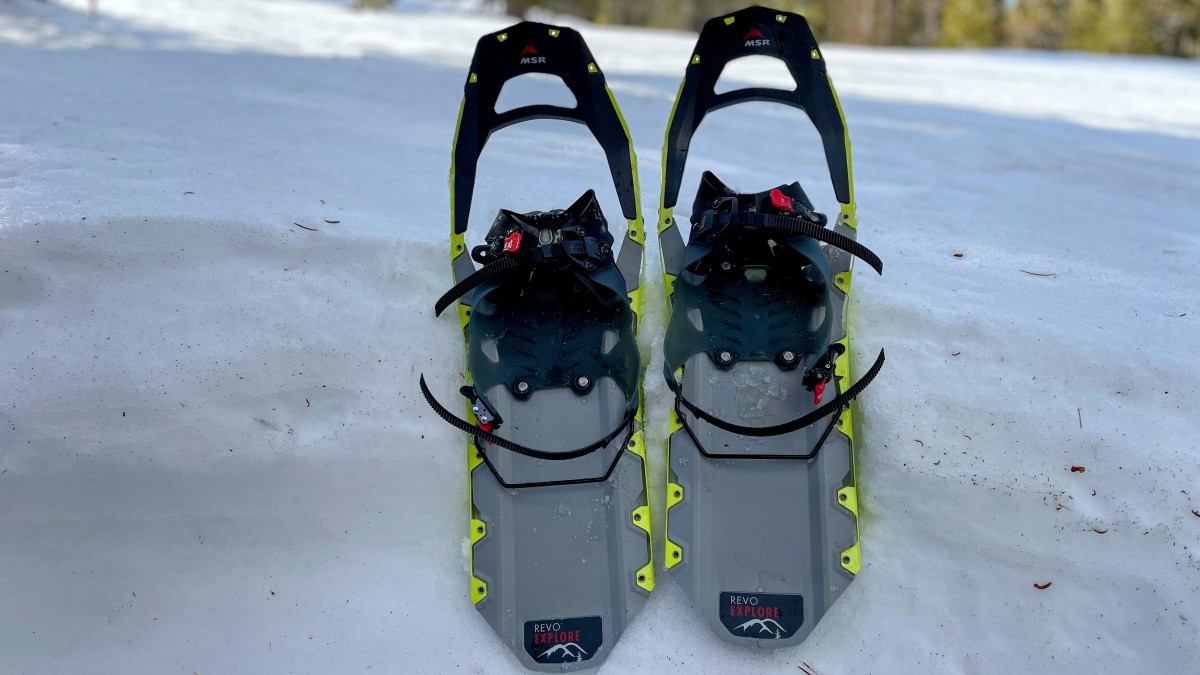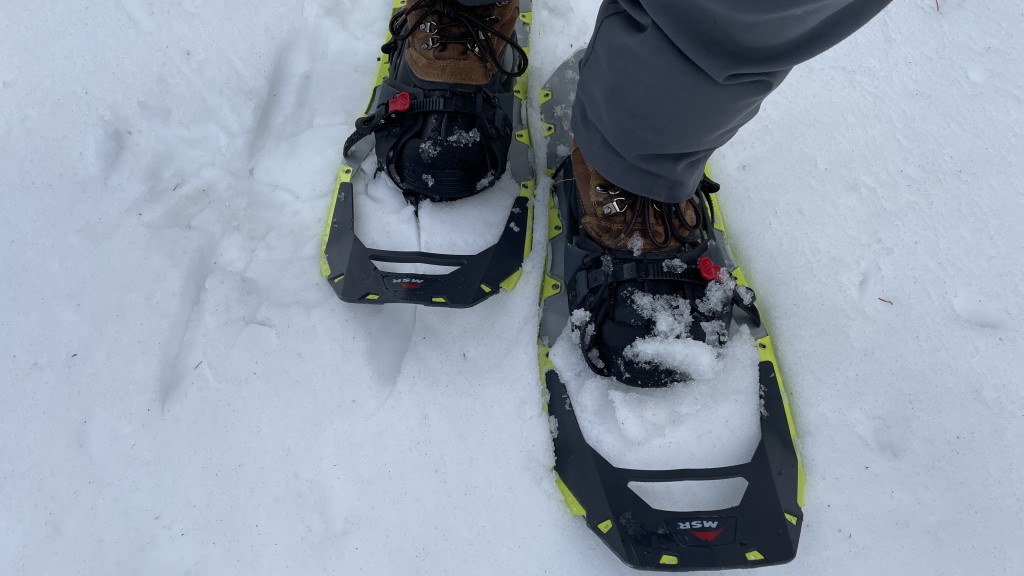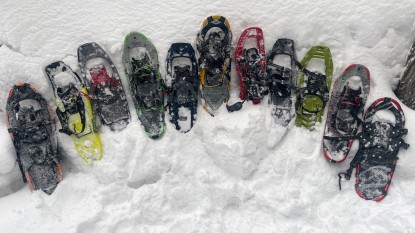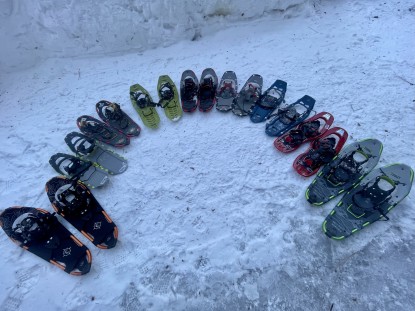Our Verdict
Compare to Similar Products
 This Product
MSR Revo Explore | |||||
|---|---|---|---|---|---|
| Awards | High Performance Affordability | Best for Fresh Deep Snow | Best for Trails | Best on A Tight Budget | |
| Price | $250.70 at Amazon Compare at 3 sellers | $169.95 at REI Compare at 3 sellers | $220 List $219.95 at Amazon | $300 List $289.95 at Backcountry | $80 List $93.99 at Amazon |
Overall Score  |
|||||
| Star Rating | |||||
| Bottom Line | This is a decent snowshoe with a weird flaw of falling off unexpectedly | This reliable and well-priced snowshoe is versatile and easy to use | A good choice for off trail travel and softer snow | A good choice for firm, hard packed snow when you don't need a ton of float | Most cheap snowshoes have poor bindings, but we found the G2 to be comfy and secure |
| Rating Categories | MSR Revo Explore | MSR Evo Trail | Crescent Moon Big S... | TSL Symbioz Hyperfl... | G2 Ratchet Binding |
| Flotation (30%) | |||||
| Traction (30%) | |||||
| Walkability (20%) | |||||
| Bindings (20%) | |||||
| Specs | MSR Revo Explore | MSR Evo Trail | Crescent Moon Big S... | TSL Symbioz Hyperfl... | G2 Ratchet Binding |
| Measured Weight (per pair) | 4.3 lbs | 3.7 lbs | 5.1 lbs | 4.6 lbs | 4.5 lbs |
| Sizes Available | 22", 25" | 22" (one size) | 32" (one size) | 20.5" (S), 23.5" (M), 27" (L) | 22", 25", 30", 36" |
| Binding System | Ratchet straps with plastic buckles | Rubber net and straps with pin-in-hole | Rubber straps with plastic buckles | Combination of rigid plastic, nylon straps, cam locks, and ratchet style straps | Ratchet straps with plastic buckles, EVA padding, rubber tension straps |
| Frame Material | Steel | Plastic and steel | Aluminum | Composite | Aluminum |
| Measured Surface Area | 194 sq in | 183 sq in | 256 sq in | 162 sq in | 225 sq in |
| Measured Dimensions | 25"L x 8"W | 24"L x 8"W | 32"L x 10"W | 22"L x 8"W | 31"L x 9"W |
| Binding/Deck Connection | Hinged | Hinged | Strapped | Hinged | Hinged |
| Crampon/Traction Aids | Steel crampons, rails, and teeth | Steel crampons and rails | Steel crampons | Steel crampons and teeth | Aluminum crampons and teeth |
| Deck Material | Polypropylene | Polypropylene | Polyurethane fabric | Composite | Polyethylene fabric |
| Heel Lift | Yes | No | Optional | Yes | Yes |
| Flotation Tails Sold Separately? | Yes | Yes | No | No | No |
| Men's and Women's Versions? | Yes | Unisex | Yes | Unisex | Unisex |
| Optimum Weight Load (per manufacturer) | up to 180 lbs (size 22") 120-220 lbs (size 25") 150-280 lbs (size 30") |
up to 180 lbs | up to 225 lbs | 65-180 lbs (size S) 110-260 lbs (size M) 150-300 lbs (size L) |
up to 150 lbs (size 21") up to 200 lbs (size 25") up to 250 lbs (size 30") up to 300 lbs (size 36") |
| Tested Size | 25" | 22" | 32" | M | 30" |
Our Analysis and Test Results
MSR has made snowshoes for a long time and currently makes many different models. The Revo Explore has respectable flotation and traction, and while they're easy to put on, we found a problem with them staying on.
Performance Comparison
Flotation
This is the most important job a snowshoe has to do, and the Revo Explore does it decently. The deck tapers towards the tail, but only slightly, for a minimal loss of surface area. The steel frame and plastic deck are fairly rigid, and our testers felt this enhanced the flotation overall.
Traction
The Revo Explore has a respectable amount of traction. The binding cleat sports two large steel teeth. Part of the binding hinge attachment is a lateral steel rail that is toothed, and this falls just under the ball of the user's foot. The steel frame is serrated throughout. The plastic deck sports some lateral ridges underneath and behind the user's heel. These are slightly recessed and won't engage on the firmest of snow. On steep downhills, it's natural for a lot of a hiker's weight to be on the back of the snowshoe. Our testers found that the longer deck, coupled with only a pair of fairly shallow plastic ridges in the back, meant that the Revo could be a little squirrely when heading down steep, firm snow.
Walkability
The Explore has a rigid, hinged connection attaching the binding to the deck. While many of our testers prefer the precision this gives, the lack of flexibility can lead to an unnatural gait on well-packed or groomed trails. The same is true of the deck materials and construction. Their rigid properties are a boon on steeper rougher ground but feel clunky on the flat and firm. The deck tapers slightly, just under an inch from where your toe sits to the snowshoe's tail, making it slightly harder to step on the back of the other shoe. The Explore also has a pair of heel lifters (MSR calls them "Ergo Televators") for use on long consistent uphills.
Bindings
Our testing team was somewhat divided on how easy it is to use the Revo Explore. Those of us familiar with snowboard bindings instantly understood how to use and adjust the ratchet straps. For the non-snowboarders amongst us, there was a bit of a learning curve. That being said, once you figure out how the tightening and release levers work on the ratchet buckle, these are pretty fast to put on and remove.
When used with stiff or very well-insulated boots, we found this to be a reasonably comfortable snowshoe. With only two straps holding the snowshoe to your boot, our testers tended to keep both ratcheted down pretty tightly. With softer or more flexible footwear, we suspect that this could lead to pinching in the area of the toe strap. MSR has since added some foam padding here, which may help mitigate the issue.
Still, this was the most disappointing metric for the Explore. Almost every tester had it fall off their foot spontaneously at least once. After some investigation, we think we found the cause: when the toe strap is cranked down really tight, the release lever is on a bit of a hair-trigger. It's easy to bump it unknowingly (on rocks, plants, or a trekking pole), which can let the strap out of the buckle. Since there is just one strap on the top of your foot, you then step right out of the snowshoe when this occurs.
Wearing these snowshoes on the correct feet can help mitigate this problem. This keeps the buckle on the outside and prevents it from being bumped by the other snowshoe. Still, it's easier than we would like to trigger the release lever unintentionally. Since there's only one strap on the top of the feet, that often means losing a snowshoe.
Should You Buy the MSR Revo Explore?
The Revo Explore is a decent all-around snowshoe. Our testing team think it is a good choice for the hiker who wants to get out a bit more in the winter but isn't planning on any particularly remote or technical trips.
What Other Snowshoes Should You Consider?
Hikers looking for a good versatile snowshoe would do well to consider at least two other models. The MSR Evo Trail has a bit less flotation but is superior in most other ways, especially the bindings, which are easy to use and secure. The MSR Lightning Ascent is one of the top snowshoes in our review and does everything we expect from a snowshoe quite well. The flotation of these models can be increased with the aftermarket tails.















